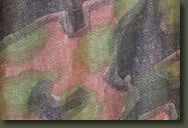Camouflage of the SS
The German military's introduction of camouflage starting primarily in the Great War was a revolutionary advance in military tactics, emphasizing stealth and concealment over the awe-inspiring bold colors of old. Camouflage allowed soldaten to blend more with their environment, and gain the edge of surprise in offensive maneuvering. During World War II, Germany worked tirelessly in their development of newer, more complex camouflage patterns, eventually developing around 20 individually recognized patterns. While the Allied forces were initially skeptical about the odd colorations they saw, the effectiveness was undeniable, and the German groundwork helped develop what is now standard operational practice.
Our unit's primary portrayal timeframe is late Winter through Autumn of 1944, so we allow our troops to use any of the authorized SS camouflage patterns from early Planetree through Dot 44.
PLANETREE
(SS-Platanenmuster)
Planetree is the first camouflage pattern developed for use in the Waffen-SS, being distributed from the mid-1930's to the mid 1940's. Planetree consists of the then-typical green based Spring side and brown based Autumn side. Planetree's Spring side is a tri-color mix of greens and brown, with a black disruptive overprinting. It is also characteristic for having numerals printed throughout the fabric.
OAK A
(SS-Eichenlaubmuster)
Oak A is a five color disruptive camo with a Spring/Summer color scheme based on olive drab, and an Autumn color scheme based on chocolate brown. Oak A is a derivative of the Planetree pattern, and was introduced for wear in the early 1940's. Oak A was utilized in the manufacture of reversible smocks, Type II helmet covers, zeltbahns and caps.
OAK B
(SS-Beringt Eichenlaubmuster)
Oak B is a six-color ringed version of the Oak A pattern, also based on Planetree. It has the two reversible color schemes: a brown and black Autumn variety and green and brown Spring type. Oak B was also introduced in the early 1940's, though it is debated which of the two Oak leaf patterns was indeed the earliest. In addition to smocks, helmet covers and zeltbahns, Oak B was also used for a late-war HBT drill uniform.
BLURRED EDGE
(SS-Rauchtarnmuster)
Blurred Edge is one of the most prevalent styles of camouflage used in the war, being authorized for wear from the late 1930's to nearly the end of the war. The colors used in Blurred Edge are identical to the Planetree design in both seasonal varieties; the only difference is the style of black overprint giving it the characteristic smokey appearance. Blurred Edge is used on both types of smocks, helmet covers and zeltbahns.
DOT 44 / PEA PATTERN
(SS-Erbsenmuster)
Dot 44 was manufactured late in the war as the first functional year-round camouflage. It contains five colors speckled throughout: green, olive, brown, black, and tan. Dot 44 was used primarily for a new style drill uniform which replaced the typical camo smock, and was not known to have been authorized for helmet covers or caps.
Field Camouflage Tactics
Camouflage smocks and helmet covers are to be worn whenever possible in combat. Despite the mix of colors and patterns though, enemies can often seek out approaching soldaten by their outlines; this is especially true in darker or smoky situations where shape over color is used to identify potential targets. Therefore, soldiers would use the loops in smocks or uniforms to hold surrounding vegetation to break up the detectable visual line, it is their designed purpose. Additionally, darker situations also lend themselves to easier recognition of light reflection off lighter toned surfaces like skin, eyes, and teeth. To assist in additional concealment, soldaten would rub their faces with dirt or burned cork; this both darkened the face and matted the surface oils to prevent excessive reflection.




